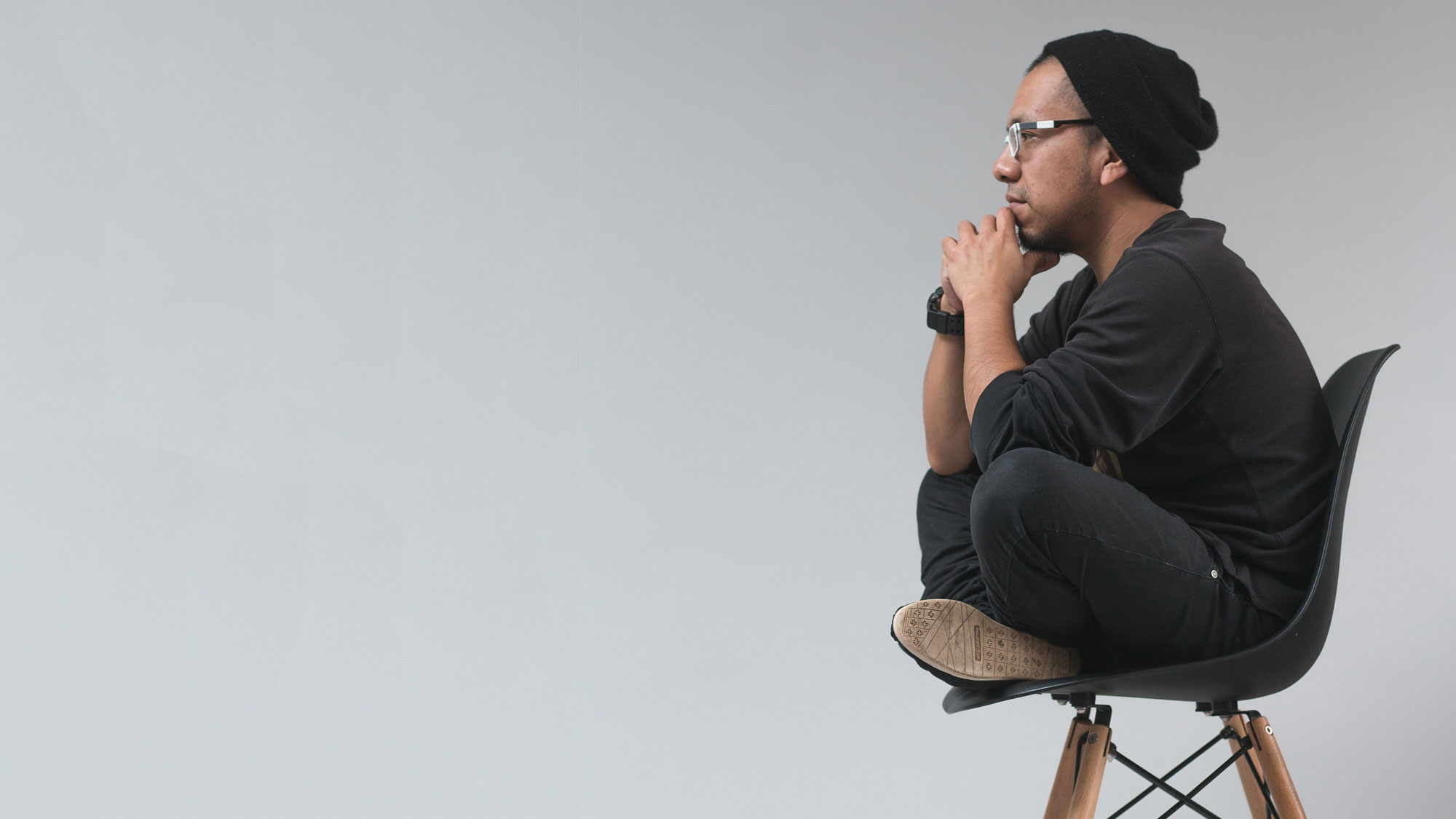Design Sprint 101: How to Innovate Faster and Find Winning Solutions
Don’t judge a book by its cover or a process by its name.
The design sprint is not just about design, not only for designers, nor it has anything to do with running. But it has plenty to do with guiding the team’s innovation efforts. A problem, after all, is at the core of good design and successful innovation. And that’s exactly what a sprint is meant to do – solve a well-defined problem in just a few days.
In today’s article, we will get to learn more about the highly praised technique, what it is, when it works, why it fails, and much more.
Whether you are a product manager, a marketer, an engineer, or any other professional involved in creating and launching innovation, I hope that this article will provide some valuable insights and tips for running a successful design sprint.
Table of contents
.jpg?width=1000&height=540&name=age-barros-_TMzs6SJZHY-unsplash%20(2).jpg)
What is a Design Sprint?
The design sprint is a customer-centric framework that merges the best aspects of lean development and design thinking into a five-day process for finding the best solution for clearly defined problems through prototyping and testing with real customers.
It’s a short and sweet way to push you and your team out of the same old ways of solving problems, giving “teams a shortcut to learning without building and launching” (GV).
First, a little bit of history.
The design sprint was originally created back in 2010 by author and consultant Jake Knapp. It is a modern take on modern problems, introduced in a fast-paced, and competitive environment, where investing time into projects is seen as a luxury. After all, the design sprint’s charm hides in its rapid pace and short, five-day span in which all the core development steps are taken care of – from ideas to customer-focused tests with real prototypes. No surprise that many well-known and creative organizations have used and loved the method.
The story goes that Jake was running a brainstorming session back at Google Ventures (now GV) when the session was interrupted by one attendee with a burning question every introvert had in such an activity: why are we doing this, does this even work?
After looking into some past sessions and statistics, Jake realized that he was running hundreds of them yet the truly brilliant ideas that got implemented came from a completely different place – solitary ideation.
Jake Later argued against the effectiveness of brainstorming, and while we generally agree, the reality isn’t as black and white. There is never a single perfect process. Rather, there is a place and a time for different tools and methods, and there are best practices to do them right.
However, that aside, we can be happy that brainstorming did not work out at GV because in the end, that gave us the design sprint.
“Design sprints offer a path to solve big problems, test new ideas, get more done, and do it faster”
- J. Knapp
How Exactly Does It Work?
To get the design sprint going you need three things planned and locked in and those are a clearly defined problem, good timing, and the right team.
- Problem. At its core, a design sprint is a problem-solving process, so to run one you must have a defined problem. A challenge at hand must be first worth the time and effort and have multiple possible solutions.
- Timing. The design sprint might be short, but it is demanding. It requires people to pause their daily tasks and work on the project full-time for the period that it is running. It’s not enough to do it for an hour here and another hour there, as cutting corners can lead to losing momentum. Turning off phones, setting out-of-the-office emails, and putting aside all other daily tasks is a sacrifice that should be asked only for worthy ideas and done only when everyone, leadership included, is onboard to commit a whole week to this non-stop. And obviously, this isn’t the case for most ideas.
- Team. A perfect team should consist of designers, engineers, product managers, and customer success or support specialists. In addition, there should be a leader (facilitator) capable of guiding the process and finally – a decider with deep knowledge of the business and the topic and with the power to make final decisions on what to veto, and with what to proceed.
Even with all three at your disposal, it really gets down to alignment and availability, openness to tackle a big issue that would clearly generate value for everyone involved in the process. Thus, just like with most teamwork-oriented activities, the quality of the sprint heavily relies on communication.
In short, a design sprint starts with a clear problem. The team works together to draw a customer journey map and pinpoints the outcome that must be reached at the end of the sprint. Once that is set, the map gets broken down into the “how”, working your way back from the outcomes to where you are now.
The success of the design sprint gets down to being aligned and wanting to tackle a big issue that would clearly generate value for everyone involved in the process.
Once the target is clear, each team member sketches a solution. Then the project proceeds to the voting phase and the highest-rated solution (or elements of few) gets prototyped. Once the prototype is ready to be tested, it moves to a selected group of people for testing.
Interviews
Interviews take place at the end of the sprint on Fridays (or Thursdays if you are running sprint 2.0, on that - later).
A common interview step is to conduct user testing or usability testing to gather feedback on the prototype. Usually, this step involves observing users as they interact with the prototype and asking them questions about their experience, in order to identify areas that may need further refinement.
Consider who will be testing the prototype. Their unbiased opinions and input are crucial, so you need real customers. Not closest colleagues, friends, or family. After all, the test results should be the decisive factor in determining whether you should proceed with the project or end it.
It is not uncommon to employ internal members (from different departments) to take part in user tests. It is quite useful for big organizations, where they can dip into the large pool of employees and invite people from completely different departments. It saves time spent on the recruitment process and cuts costs, as involving external users might require compensation.
However, it might not be a feasible option for small organizations where every member is too involved in the design sprint and would be unable to provide unbiased feedback. In such a case, you need to source your users from outside the organization.
There are six key steps in the testing process:
- User group: identify the type of people who are most likely to use your prototype.
- User persona: based on the first step, create several user personas that represent typical users who might interact with your final product.
- Recruitment: use social media, and email campaigns or reach out to your existing customers and invite them to join the tests.
- Screening: screen and assess the experience, knowledge, and behaviors of potential customers to ensure they meet the criteria for your user personas.
- Schedule: set up a time for the interview sessions and be sure to set a clear structure, timeline, and instructions for the process.
- Test: the user testing, observe how participants interact with your prototype, ask relevant questions, and gather feedback to inform future developments.
The observation can be done by using a direct feed camera in a designated testing area, or if testing is conducted online, the user and your team can interact in a live call.
However, observation is the keyword here – only the test facilitators should be the ones that do the talking and guide the interview. The rest of your team should simply observe and allow the process to unravel to get the purest, unbiased user opinion.
And so, at the end of the sprint, you are done with the full process of creating a prototype of the product (even if it’s something as simple as a mockup) – in just five days! And finally, having real users test and review your product can save resources by showing whether your product idea is worth the investment, and if so, how to move forward with it.
With that said, let’s dive a little deeper into the whole process.
%20(1).jpg?width=800&height=493&name=startae-team-MhBJLFJ_5Tc-unsplash%20(2)%20(1).jpg)
Elements of the Design Sprint
To begin with, let’s examine who makes the right team.
First, of course, there’s cross-functionality. If everyone comes from the same unit or department, you will hardly consider enough diverse views, get possible solutions, or have a chance to create a viable prototype.
Then again, going extreme towards the other end and inviting everyone to participate also dooms the process. Too many people will simply derail the project and it will be very difficult to manage. Thus, you must find the middle ground.
Normally, it is recommended to stick with a group of anywhere from four to around 10 people and each member should have a clear, value-adding role.
Team Roles
- Decider is the official decision-maker, with the authority to greenlight the project or put a full stop to it. Typically, the decider is a founder, CEO, VP, or another decision-maker with an understanding of the design sprint’s goal, and the ability to grant the resources needed to pursue said goal after the sprint.
- Facilitator is the one who guides the project and keeps it on track. They act as a guide and supervisor for each task, leading everyone through the process and ensuring that all steps are completed within the agreed timeframe. Prior experience or knowledge on how to facilitate and run a Design Sprint is necessary for quality results.
- Customer representative is the voice of your customers, best familiar with their needs and desires. As the customers' needs are at the core of the design sprint, an expert in this area will help to keep the team grounded and focused.
- Designer is a crucial member who is familiar with customer research and can turn a rough sketch into a design or prototype, with their knowledge of UX and UI or industrial design, as well as applicable tools depending on the domain.
- Engineer brings a set of technical skills on deck. If you are working on either software or hardware, you will need technical knowledge, thus having an engineer (or few – depending on the size and complexity of your problem) would assist the progress greatly.
- Marketing expert is an important member of the design sprint team, bringing an understanding of customer behavior, market trends, and how to effectively communicate ideas to the target audience and how to differentiate the product from competitors.
This is not a definitive list of people that you must include. As with many components of the design sprint, the team heavily depends on your unique problem, industry, and market in which you are competing.
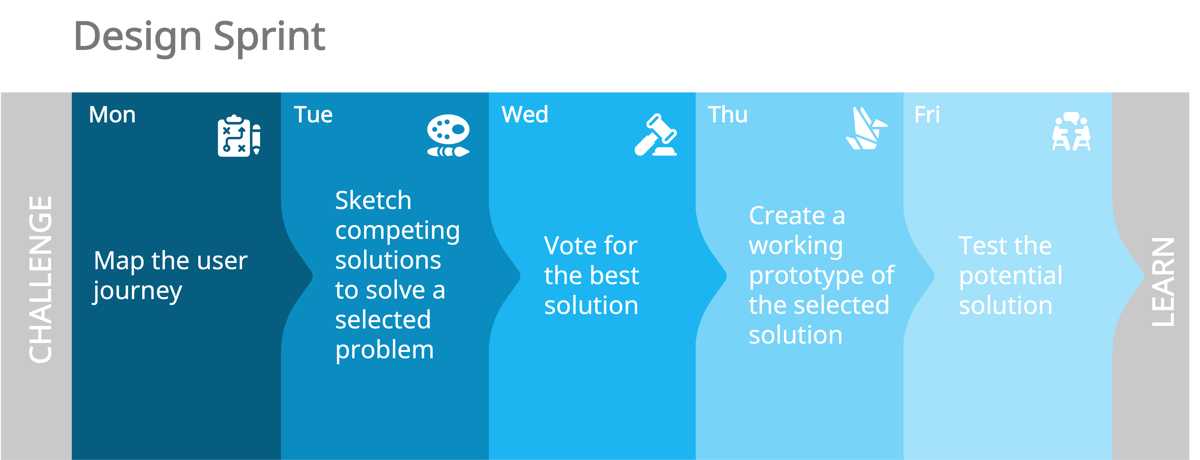
Phases of the Design Sprint
The Design Sprint spans from Monday to Friday and is divided into five main tasks that must be covered during the period: mapping, sketching, voting and deciding, prototyping, and testing.
Let’s see what must be done each day.
- Monday: map.
Monday should be kicked off with a little bit of planning. While everyone should know in advance why they are there, on Monday, you should create a structure and provide the focus for the week ahead. The structure will help to stay on track, avoid time waste, and get everyone aligned.
The first part of the day is spent setting a long-term goal and mapping out the challenge. While the challenge should be bold, otherwise there’s no point in doing it, keep in mind that it must be something on which you can make progress in a week.
Then, utilize the knowledge of the people you have on your team and gather their unique insights on the matter as it will help you select and shape the clear, final goal and the target audience (user).
Finally, it’s time to map. What must happen for your user to reach the goal (i.e., customer to buy a product X)? Your map should fill in the blank space between these two ends. It is recommended to create one common map, drawn by the facilitator that the whole team will follow for the rest of the week. - Tuesday: sketch.
Tuesday is the time to channel your inner Bob Ross.
Every team member draws an individual sketch. Sketching here does not mean an artistic draw-off, it’s not about the talent and the beauty, but about illustrating your ideas. It doesn’t need to be perfect or complete, rather just make your ideas clear, and easy to understand. Boxes, arrows, and stick figures are more than adequate.
Keep in mind that this has to be a practical sketch. Try to keep the following questions in mind to stay grounded:1. Who will take part/is needed to execute the plan?
2. Who is responsible for developing each step?
3. What tools will be used to reach the final goal?
4. How much time would it take?
5. What are the success criteria, KPIs? - Wednesday: decide.
By midweek, you will have a stack of various solutions and it will be time to sift through them to decide which one is best fitting and worth developing. By no means you must eliminate all, but one. Rather, you can combine parts of several ideas into a final, ultimate version. Like a puzzle.
Elimination and selection are done by each team member voting on things that they like and deem interesting/useful/doable. The topmost voted elements creates a final solution.
If you have a strong team and plenty of customers for testing, and just can’t settle on one idea, you can choose two solutions and work on two separate prototypes A/B test style: but that means that you’ll have even more work to do in already a tight and busy period of time.
Creating a storyboard out of the selected pieces can help better understand how the target user would use or consume your new solution and help identify potential issues or bottlenecks.
The storyboard will ideally help you improve upon the weaker aspects and guide the creation of a mockup solution – the storyboard works as a step-by-step guide for a prototype. - Thursday: prototype.
This is the day for your designers and engineers to really shine the brightest. Thursday’s goal is to create an interactive and usable prototype. Now, of course, it would be best to have a realistic prototype, whether it is an app, service, or a pair of sneakers, whatever it is you are trying to create.
If you don’t have enough workforce or you’re short on time, prioritize developing a realistic prototype that can convey your concept effectively without requiring extensive explanation to testers. It is almost always better to focus on the value proposition instead of the appearance of the prototype. Thus, focus on features and how a customer might use the prototype instead of worrying about how it looks.
Meanwhile, the other team members should work to a) assist the designers and engineers however they can, for example by creating an imaginary brand and marketing for the product if such collateral is needed, and b) prepare for the upcoming tests for Friday. - Friday: test.
The finish line of the sprint is near and by the end of Friday, you will know how well your new solution fared.
Show your prototype to the selected group of testers and observe them use it in a one-to-one type of interview. It’s important to allocate sufficient time to each user during the sprint and track their reactions, feelings, and any important questions that may arise.
This finally clarifies what and how things should be done to satisfy customers’ needs and solve the problem. You don’t need to wait a long time to gather data, rather, you will see how your prototype gets used on the spot and immediately collect insights that will help you improve upon it for the development of the “real deal”.
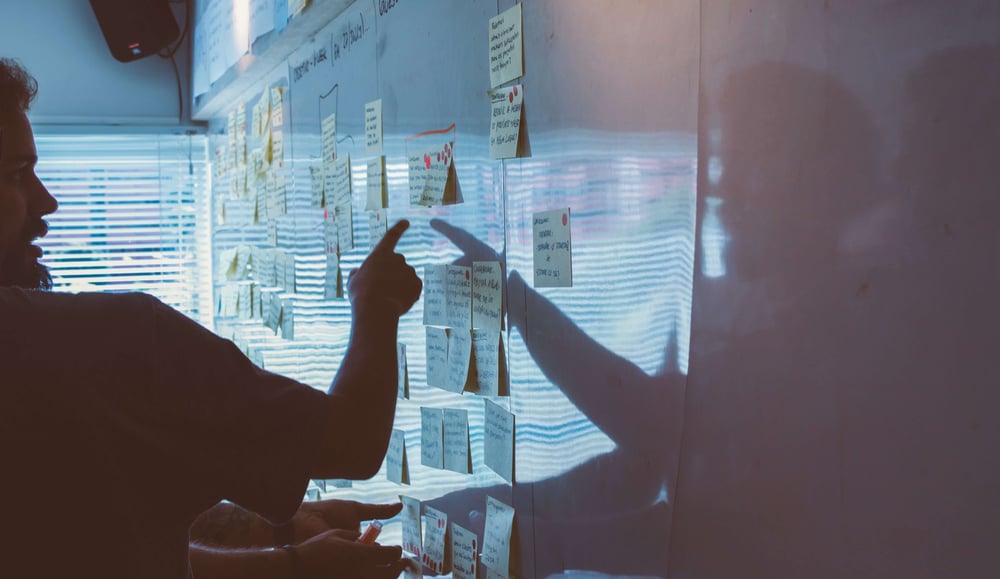
Benefits of the Design Sprint for Innovation
As with most processes and techniques, the design sprint is not perfect, and it isn’t a cure-all. However, when done right and for the right reasons, it delivers tremendous benefits. It can be used at the beginning of pretty much every ambitious project, especially the ones that are looking to create new products, services, or experiences that are tailored to the needs of the customer or user.
The design sprint is an easy and fast way to look over all possible solutions to a problem, especially when the project is time-bound. In addition, the rapid pace and pressing deadline, and gathering of a diverse team from various departments can offer the following benefits:
- Speed: Design sprints can help teams rapidly generate and test ideas, allowing them to move quickly through the ideation and prototyping process. This can help businesses respond much more quickly to changing market conditions or customer needs. Instead of many months’ worth of plans and meetings, you can get everyone on the same page, and even get real feedback on your plans in just one calendar week.
- Collaboration: Design sprints require a collaborative and cross-functional team, that brings together people from diverse backgrounds and perspectives. This can help teams generate more creative and innovative ideas and solutions and increase alignment between these stakeholders as everyone will have had the same shared experience.
- User-centered: Design sprints focus on understanding the needs and behaviors of users, which can help teams create products or services that meet real customer needs.
- Iterative: Design sprints involve a rapid prototyping and testing process, which allows teams to quickly identify and address problems with their ideas. This can help teams refine their solutions and create better products or services.
- Low-risk: Design sprints offer a low-risk way to test and validate ideas before investing significant time and resources into development. This can help businesses avoid costly mistakes and ensure that their products or services are more likely to be successful.
- Innovation: Design sprints are specifically designed to help teams generate innovative solutions to complex problems. By providing a structured and focused process, design sprints can help teams break out of their usual ways of thinking and come up with truly novel ideas.
In general, design sprints can offer numerous benefits for innovation, from speed and collaboration to user-centered design and low-risk prototyping. By leveraging these benefits, businesses can create more successful and innovative products and services.
It is better to receive bad news after five days rather than after two years of development.
However, it's important to remember that while design sprints can be incredibly useful, they are not a silver bullet and may not work for every project or team.
Design Sprint 2.0
In recent years an updated concept of design sprint was introduced by Jake Knapp. The main concern regarding the original design sprint was that it took a lot of dedication.
Yes, 5 days is not a lot in the bigger picture, but to be able to block off 5 days of work in a row, push aside all daily tasks and usual assignments, and completely dedicate one's time to a sprint is a lot to ask. Hence, Jake and his team looked for a workaround and came up with a shorter version of the original sprint – a design sprint 2.0.
So, what’s different?
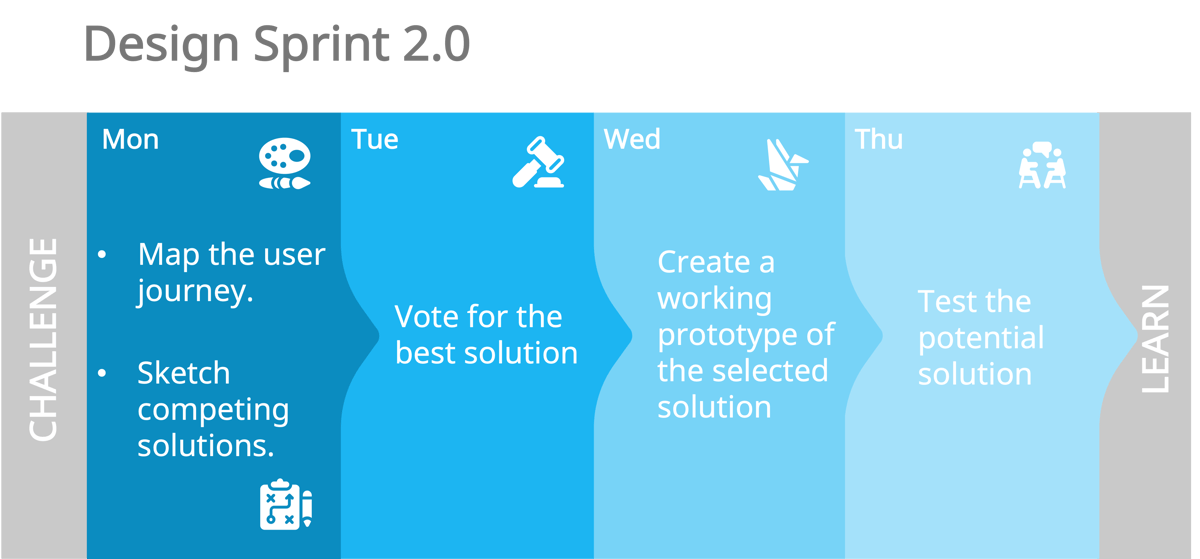
First, the biggest change in the process is that Friday is off and the whole sprint gets wrapped up by Thursday. Now, how does that work?
By introducing more tools and different techniques to get to the bottom of things, design sprint 2.0 makes it possible to start the sketching step already on Monday. Hence, every other step – voting, prototyping, and testing moves a day, shortening the whole process to only four days.
In addition, it introduces a new element to sprint – external expert interviews. Expert interviews are a technique used to gather insights from people who have a deep understanding of the problem sprint’s team is working on. In the original design sprint, such interviews were used to focus on internal knowledge, shared in brainstorming and discussion sessions during the sprint run.
However, design sprint 2.0 puts emphasis on external insights and such interviews can be (and normally are) conducted before the sprint. This provides additional knowledge and helps the team make better-informed decisions and move at a faster pace.
This leads the team to produce their solution sketches faster too, which is now done on Monday afternoon along with the user journey mapping. This allows the team to maintain momentum and immediately capture all the ideas that members have generated, instead of delaying the process for another day.
On one hand, a shorter week and faster pace might look appealing but do consider that nothing has been removed from the process. So, an obvious disadvantage of design sprint 2.0 is how incredibly intense it can get. Especially, if you will be running without prior design sprint experience and strong facilitation skills.
It might not be enough time for long breaks, team lunches, and quality discussions about the topic. Everyone must be equipped with knowledge in the first hour of the sprint.
So, while in the end, it can save time, do consider the human factor of this speed run and whether your team is really capable of doing this.
Why do Design Sprints Fail?
The design sprint is destined to fail for ambiguous problems without any clear solutions, small iterations, and problems to which even partial solutions might take years to develop.
Thus, it is essential to evaluate each project one by one and determine whether the sprint is really a suitable approach or whether it would benefit from a different process, for example, the Phase-Gate.
With that said, sometimes even with the best intentions, design sprints are just destined to fail, causing the team to stagnate, lose focus or just drop the project halfway. So, what are the most common reasons?
- Lack of clarity. Without clear guidelines, structure, and proper explanation of the goals, people are unable to reach goals and perform in the sprint.
- Poor team dynamics or composition. People without the required knowledge and skillsets will be unable to run the sprint from start to finish. Likewise, running a bigger project with everyone from the same department is impossible, leading to tunnel vision.
- Rushing the process. The design sprint is already a tight squeeze to deliver a prototype and it might be tempting to cut it into an even shorter period, especially with design sprint 2.0 emerging. However, it's important to remember that each step serves a crucial purpose in the process. To fully benefit from the sprint, it's recommended to complete all the steps as intended.
- Poor facilitation. The quality of the design sprint heavily depends on the facilitation. Due to this reason, it is not uncommon to outsource this role to a professional outside of the organization with the experience to run the sprint. A bad facilitator might not be able to effectively manage the process, facilitate quality discussion, and answer questions, leaving members in the dark, while keeping everything on schedule.
- Failure to follow up. A design sprint should not be an isolated event or a one-time exercise. It can lead to wasted time, frustration among team members, and a missed opportunity to bring new and innovative ideas to reality. It's important to have a plan for implementing the solutions generated during the sprint.
The design sprint does not work for ambiguous problems, small iterations, and problems for which solutions will take years to develop.
Going Virtual
The original design sprint is typically conducted in person, with all team members present and sharing ideas. The quality of the sprint relies heavily on the openness and collaboration of everyone involved. Virtual tools simply cannot fully replace the benefits of intense face-to-face collaboration, but a combination of virtual and in-person methods can help achieve the best results from a design sprint.
However, with the rise of remote work, many processes had to be adapted to a different environment. The same goes for the design sprint. Its flexibility made it possible to run a successful session virtually too.
But this requires prior experience in running the sprint face-to-face, and strong facilitation skills to ensure effective virtual collaboration and efficient time management.
But before you commit to running a virtual design sprint, remember the good old truth, that just because you can, it does not mean you should – a design sprint is a process created first and foremost for an in-person setting and to get the best results, I would highly recommend trying and organizing it in such way.
However, if it is not possible to meet your team in person, a virtual design sprint might just do the trick for you.
Before trying to run a virtual sprint:
- Gain experience: run at least your (and your teams’) very first design sprint face-to-face to gain an understanding of the flow, challenges, and what works best.
- Try digital tools: use digital tools in your face-to-face design sprints to help you organize and document the process.
- Online user testing: use online user testing platforms to increase participation and gauge the different tools and methods that might work for you in the future. Such platforms include Testlio, UsabilityHub, Userfeel or similar.
Taking these steps before going fully virtually will serve as a good school to learn the ropes, give experience in managing communications, documentation, and user testing, and will make the transition experience much smoother. And with this, you can then take the action in the virtual space.
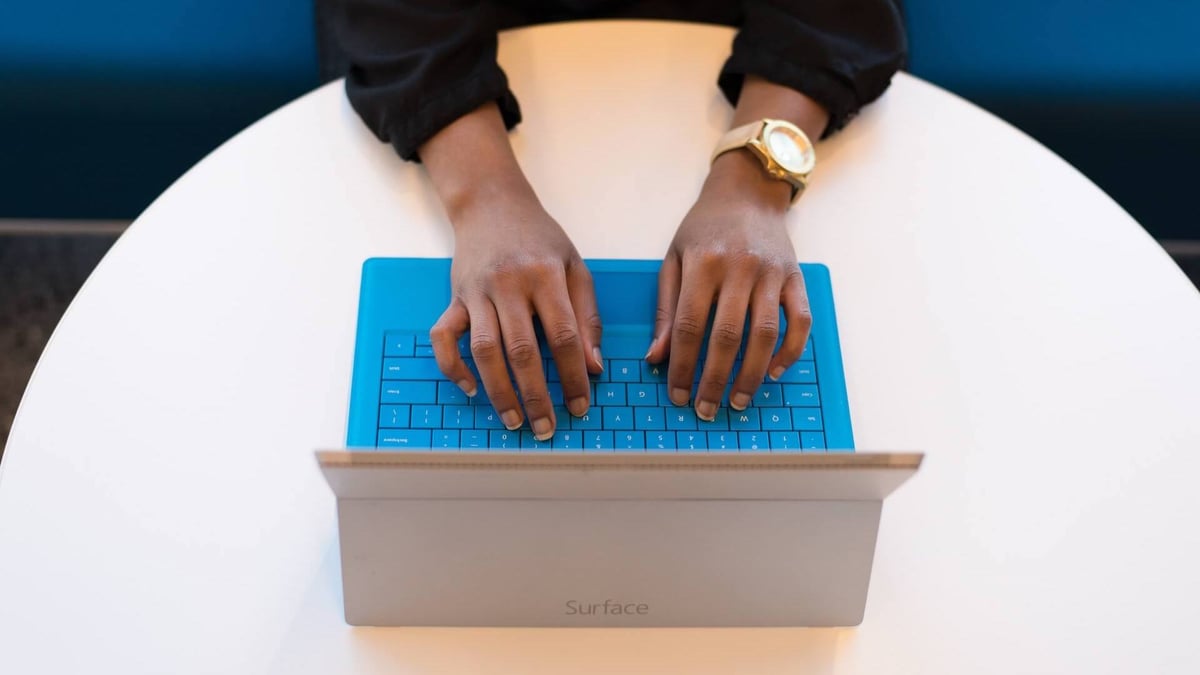
Steps to a successful virtual design sprint:
- Pick the right tools: Probably the most important step to succeed at a virtual design sprint is to have the right tools. Consider the tools and ways of communicating in face-to-face interactions, and then try to mimic that into digital platforms that support collaboration. In addition, consider the features and capabilities of the platform, such as the ability to share files, collaborate in real-time, organize ideas, sketch, and if need be – conduct interviews.
-
- Video calls: video conferences are essential for running a virtual sprint. Popular options include Zoom, Google Meet, and Microsoft Teams.
- Whiteboard: in-person sprint relies on quick drafting and sketching ideas on sticky notes and then placing them whole on the walls for everyone to see and discuss at their own pace, so having a virtual whiteboard is another must. It enables the team to collaborate and brainstorm together virtually. Some popular options include Viima, Mural, and Google Jamboard.
- Collaboration: while a lot of work during the design sprint happens individually, teamwork is still at the center of it all, so you need tools that enable your team to work together on documents, presentations, and similar in real-time. Popular options include Google Docs, Dropbox Paper, and Microsoft OneDrive.
- Design: Visual work is a big part of the design sprint. Sketching customer journeys, solutions, and even prototyping is done with design software. Some tools to consider are Sketch, Figma, and Adobe XD.
- Management: Finally, you need to consider organization, documentation, and management of the whole process. A good system will help you stay on track during the design sprint. Popular options are Trello, Asana, and Viima. On top of the mentioned functions, Viima enables collaboration, idea-collection, prioritization, automatic documentation, and tracking of the overall process.
- Video calls: video conferences are essential for running a virtual sprint. Popular options include Zoom, Google Meet, and Microsoft Teams.
- Define the process: Review the design sprint process and identify the steps that will be included in the digital version. Consider how each step will be adapted to the digital environment and communicate the process to the team.
- Set up the environment: Set up the digital environment in advance of the sprint. This may include creating a digital whiteboard or workspace, uploading relevant documents or information, and setting up any necessary integrations or tools.
- Prepare the team: Ensure that all team members are comfortable with the digital platform and have the necessary access and permissions to participate. Provide training or support as needed to help team members get up to speed.
- Run the sprint: It might be tricky and require a bit of extra work from the facilitator, but active participation and collaboration between the team members should be encouraged. Have a process in place to follow and track input and provide timely feedback.
- Follow-up: Don’t let your team’s ideas get wasted and ensure you have a way to gather and document them. Even those that did not get selected after voting, might have the potential to solve problems in the future. Provide feedback to the team on the outcomes of the run and use this time to gather feedback to improve and perfect future sprints.
Virtual design sprints might seem easier to run in many ways. It does not require people to be in one place every day, it might cause fewer distractions and help each member to focus on individual work better. It also makes it possible to work together no matter the current climate, no matter people's location.
But it requires a very well-defined, clear process in place, and might be more difficult to facilitate. In addition, regular design sprints can work as a nice team-building activity, bringing people together. However, this part might be missing during a virtual sprint.
So, while it can be an effective way to facilitate collaboration and innovation in a remote team, it requires careful planning, preparation, and the right tools.
A good way to gauge possible solutions is to just try and see how they would work in practice. Some vendors make it a little easier to try the fit by offering free user-based versions, like us here at Viima, and some have demos or other free trials.
The tools will highly depend on your individual needs, sprint goals, capabilities, and your team dynamics – consider them before making any kind of commitment.
Conclusion
The design sprint is a popular, customer-focused technique used by teams to solve well-defined problems and create new products and services with limited risks. Depending on your team's needs and availability, you can run the good old five-day sprint, the more fast-paced – four-day sprint, or a fully virtual session.
It is a fail fast, learn fast way to problem-solving that can save you and your team months upon months spent on development, designing, and testing.
However, successful design sprints require careful planning, preparation, and strong facilitation. It is important to gather a diverse and cross-functional team, define clear objectives and success criteria, and allocate sufficient time and resources for each step of the sprint.
Moreover, while sprints can be highly effective, they are not a silver bullet. It's essential to recognize their limitations and use them only when they can truly generate positive results. Design sprints work best for solving complex problems with a high degree of uncertainty, but may not be suitable for more straightforward tasks, small iterations, or problems with well-defined solutions.
Ultimately, design sprints offer a structured and efficient way to bring together diverse perspectives, rapidly prototype and test solutions, and drive innovation.


.png?width=50&height=50&name=Untitled%20design%20(1).png)





